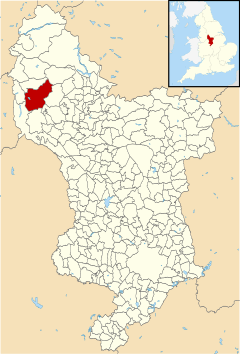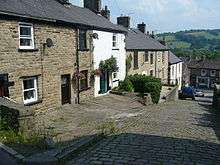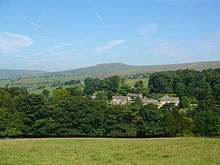Chapel-en-le-Frith
| Chapel-en-le-Frith | |
|---|---|
 View of the town from Cowlow Lane | |
 Chapel-en-le-Frith parish highlighted within Derbyshire | |
| Population | 8,635 (Parish, 2011)[1] |
| OS grid reference | SK055806 |
| Civil parish |
|
| District | |
| Shire county | |
| Region | |
| Country | England |
| Sovereign state | United Kingdom |
| Post town | HIGH PEAK |
| Postcode district | SK23 |
| Dialling code | 01298 |
| Police | Derbyshire |
| Fire | Derbyshire |
| Ambulance | East Midlands |
| EU Parliament | East Midlands |
| UK Parliament | |
Chapel-en-le-Frith /ˌtʃæpəl
Church of St Thomas Becket
The first chapel in the town (now the Church of St. Thomas Becket) was originally built by the Normans but was replaced with a larger building a hundred years later. It stands at the highest point in the town proper. The current building is now almost entirely of 18th-century construction above a crypt of 1225. Buried in the churchyard are soldiers of the Scottish army of the Duke of Hamilton who marched south in support of Charles I in 1648. After their defeat at Preston, they were marched to Chapel and imprisoned in the church for sixteen days in such squalid conditions that forty died; a further ten died when they were marched towards Cheshire. The Eccles Pike Cross stands in the churchyard, having been moved here from Ollerenshaw Farm in 1925. It is believed to be Anglo-Saxon and is covered in very worn carvings.[3]


John Wesley
John Wesley has links to the town visiting four times between 1740 and 1786. His journal documents his first visit on 28 May 28 1745 preaching in the hamlet of Chapel Milton where the miller purportedly tried to drown out John with the sound of the watermill. On his following visit twenty years later he preached in a field at Townend, and by his subsequent visit on 1 April 1782 a chapel had been built. All that remains of the original chapel is an archway inscribed "1780" at the back of the current Townend Methodist Church.[4]
Following an illness in 1748, Wesley was nursed by a classleader and housekeeper at an orphan house in Newcastle, Grace Murray. Taken with Grace, he invited her to travel with him to Ireland in 1749 where he believed them to be betrothed though they were never married. It has been suggested that his brother Charles Wesley objected to the engagement[5] though this is disputed. Subsequently Grace married John Bennett, preacher and resident of Chapel-en-le-frith, and John's last visit to Chapel-en-le-frith on 3 April 1786 at the age of 86 was at Grace's request. Grace and John Bennett are buried in Chinley Independent Chapel in Chapel Milton.[4]
Industry
There is a certain amount of industry – especially behind the church in the lowest part of the town, where the brake-lining manufacturer Ferodo was a family concern for over a hundred years; it is now part of the international conglomerate Federal-Mogul.
There is a regular market place, cobbled and raised above the High Street, which is still used every Thursday to host the local market (though due to the current economic climate the number of stalls present has declined considerably). A market cross has a faint date which may read 1636, but the cross itself is considerably older.[3]
Institutions
Chapel Poor Law Union was established in December 1837. The union workhouse was built c.1840 on the Whaley Bridge road (grid reference SK051805). It consisted of an entrance range and an accommodation block of three wings centred on an octagonal hub, an infirmary and an isolation hospital. The workhouse was later converted to an old people's home, and was demolished in the early 1980s.[6]
High Peak Radio, Independent Local Radio for High Peak and the Hope Valley, broadcasts from studios just off the High Street.
The town has its own theatre company, the Chapel Players, located just off the Market Place.
Transport
Chapel-en-le-Frith station is located one mile (1.5 km) from the town centre, on the Buxton to Manchester Piccadilly line. The other railway line passing through the town, Chapel-en-le-Frith Central has a more central disused station[n 1] built by the Midland Railway, was once one of the main lines from London to Manchester. While it no longer carries passenger traffic, it now carries a constant stream of roadstone from the quarries around Buxton. It terminates at its junction with the Hope Valley line by way of two viaducts, diverging east and west, above the Black Brook valley at Chapel Milton near Chinley signalbox.

_station_geograph-3300512-by-Ben-Brooksbank.jpg)
Sport
The town's football team is Chapel Town F.C., playing in Division One of the Manchester Football League.[7]
Moorlands
To the north lie the Dark Peak highlands, which are made up of millstone grit and are heather-covered, rugged and bleak. Here are Chinley Churn and South Head with, a little further off, Kinder Scout, which looms above the whole area. To the south is the gentler and more pastoral White Peak, consisting largely of limestone grasslands, nevertheless with spectacular bluffs and the occasional gorge. Combs Moss, a gritstone 'edge', dominates the valley in which Chapel lies from the south and Eccles Pike rises sharply above the town to its west and provides a commanding 360° viewpoint.
Education
There are two schools in the town: Chapel-en-le-Frith High School and Chapel-en-le-Frith Primary School.
TV
Scenes from the BBC TV series The Village[8] and The Secret of Crickley Hall were filmed in and around Chapel; Bowden Hall featured in both series. In 2015 Halfords made their Christmas advert around Grange Park Road in Chapel-en-le-Frith.[9]
Landmarks of the parish

Ford Hall in the east of the parish, northeast of Slacke Hall and Bowden Hall, was the home of the Reverend William Bagshaw, the 'Apostle of the Peak', after he was ejected from the vicarage of Chinley on the Act of Uniformity in 1662.[10]
Also in the east of the parish, next to a lake alongside the A623 and not nationally listed for its architecture, is the modest Bennetston Hall, which is being renovated as a hotel. Nearby are the site of Peaslow's Cross, and Rushup Hall, a modest but ornate 19th-century private house.[11]
Stodhart Lodge, a care home, is north of the town centre on the Hayfield Road, the old road to Chapel Milton and the rest of the neighbouring parish of Chinley. It has a later 19th-century extension in the neo-gothic architectural style with a datestone inscribed "JB 1869".[12]
Along the B5470 road west of the town are the linear settlements of Bridgefields, Cockyard and Tunstead Milton. Ollerenshaw Hall dates from c.1800[13] and stands below Eccles Pike.
Combs
The village of Combs, west of the town, gives its name to the adjacent Combs Reservoir. The Old Brook House (and its barn), close to the Beehive Inn in the centre of Combs, are listed buildings;[14][15] parts of the house's grand layout clearly date from the 17th and 18th centuries and, as such, it is similar to Marsh Hall closer to Chapel.[16]
In the rolling hills between Combs and Chapel is Bank Hall, extensively altered in 1872–74 for Henry Renshaw of Manchester on an ornate aerial plan with an elaborate stone balcony over the door, a bay window with fine botanical painted glass and canvas panels to the doors, formerly with painted panels by Armstrong and Caldecott. The south elevation of the house has a central Venetian doorway with columns either side of double-glazed doors—here too are voussoirs decorated with floral motifs, set in an imposing ashlar surround.[17] Its nearby lodge, by W.E.Nesfield, is also listed,[18] as is nearby Chapel railway station.[19]
Dove Holes
Dove Holes, in the southeast of the parish, has its own station. Within the village lie the earthworks of a Neolithic henge known as the Bull Ring; the site also includes an oval and bowl barrow.[20]
Notable people
- Philip Marchington (1736 in Chapel-en-le-Frith – 1808) merchant and political figure in the Nova Scotia House of Assembly in Canada from 1786 to 1793
- Peter Kirk (1860 in Townend, Chapel-en-le-Frith – 1916) British-born American businessman, founded Kirkland, Washington USA
- Hubert Selwyn Pink (1878 in Chapel-en-le-Frith – 1946) English cricketer who played for Derbyshire during the 1900 season
- Major Richard John Wrottesley, 5th Baron Wrottesley MC (1918 in Chapel-en-le-Frith – 1977), British peer and army officer.
- John Hartle (1933 in Chapel-en-le-Frith – 1968) English professional road racer who competed in national, international and Grand Prix motorcycle racing events
- Neville Buswell (born 1943 in Chapel-en-le-Frith) British actor best known for his role as Ray Langton in Coronation Street
- Lloyd Cole (born 1961 in Buxton) English singer and songwriter, lead singer of Lloyd Cole and the Commotions from 1984 to 1989, grew up in Chapel-en-le-Frith
- Ross Hockenhull (born 1961 in Chapel-en-le-Frith) British former racing driver in the 1989 International Formula 3000 season
Neighbouring settlements and landmarks
Notes and references
- Notes
- References
- ↑ "Neighbourhood Statistics". Office for National Statistics. Retrieved 18 October 2014.
- ↑ "A Brief History of the Parish". Chapel-en-le-Frith Parish Council. Retrieved 18 March 2013.
- 1 2 Sharpe, Neville T. (2002). Crosses of the Peak District. Landmark Collectors Library. ISBN 9781843060192.
- 1 2 William Braylesford, Bunting (1940). Chapel-en-le-Frith - Its History and its People (1st ed.). Manchester: Sherratt & Hughes. pp. 277–278. Retrieved 17 January 2018.
- ↑ Kenneth J, Collins (2003). John Wesley A Theological Journey (2003 ed.). Nashville Tennessee: Abingdon Press. ISBN 0-687-02788-8. Retrieved 17 January 2018.
- ↑ Higginbotham, P (2007). Workhouses of the Midlands. Stroud: Tempus. p. 27. ISBN 978-0-7524-4488-8.
- ↑ "Homepage | CHAPEL TOWN FC". Retrieved 9 September 2017.
- ↑ "New BBC TV drama The Village set in Derbyshire's Peak District". Derby Telegraph. 31 March 2013. Retrieved 4 November 2016.
- ↑ Bebbington, Gina (18 November 2014). "Schoolboy stars in Halfords TV advert". Northwich Guardian. Retrieved 8 September 2017.
- ↑ Historic England. "Ford Hall (Grade II) (1088059)". National Heritage List for England. Retrieved 18 March 2013. – its Coach House, Garden House and Bridge are all separately listed.
- ↑ Historic England. "Rushup Hall (Grade II) (1088026)". National Heritage List for England. Retrieved 18 March 2013.
- ↑ Historic England. "Stodhart Lodge (Grade II) (1298848)". National Heritage List for England. Retrieved 18 March 2013.
- ↑ Historic England. "Ollerenshaw Hall (Grade II) (1088052)". National Heritage List for England. Retrieved 18 March 2013.
- ↑ Historic England. "Old Brook House (Grade II) (1263667)". National Heritage List for England. Retrieved 18 March 2013.
- ↑ Historic England. "Barn at Brook House Farm (Grade II) (352022)". National Heritage List for England. Retrieved 18 March 2013.
- ↑ Historic England. "Marsh Hall and Barn (Grade II) (1088025)". National Heritage List for England. Retrieved 18 March 2013.
- ↑ Historic England. "Bank Hall (Grade II) (1263667)". National Heritage List for England. Retrieved 18 March 2013.
- ↑ Historic England. "Bank Hall Lodge (Grade II) (1088046)". National Heritage List for England. Retrieved 18 March 2013.
- ↑ Historic England. "Chapel-en-le-Frith Station (Grade II) (1334789)". National Heritage List for England. Retrieved 18 March 2013.
- ↑ Bull Ring Henge – Scheduled Ancient Monument Historic England. "Bull Ring henge, oval barrow and bowl barrow (1011204)". National Heritage List for England. Retrieved 18 March 2013.
External links

- Chapel-en-le-Frith Parish Council
- Chapel-en-le-Frith.com website